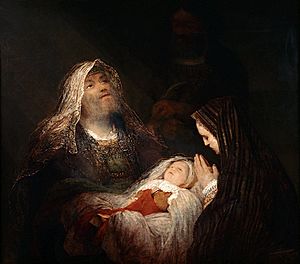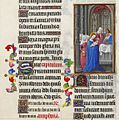Nunc dimittis facts for kids
The Nunc dimittis is a special song or prayer from the Bible. It was sung by a man named Simeon when he met the baby Jesus.
Contents
The Story of Simeon
The Bible, in the book of Luke, tells us about Simeon. He was a Jew and a very good man. The Holy Spirit had promised him something amazing: he would not die until he had seen the Saviour.
One day, Mary and Joseph brought baby Jesus to the Temple in Jerusalem. They were there for a special ceremony. Simeon was also at the Temple. When he saw Jesus, he took the baby into his arms. Then, Simeon said the words that we now call the Nunc dimittis. He was telling God that he could now die peacefully. This was because he had seen the promised Saviour.
What the Nunc dimittis Means
The words of the Nunc dimittis show Simeon's great joy and relief. He had waited a long time for this moment. He felt his life's purpose was complete. He was ready to leave this world.
The English words from the Book of Common Prayer (1662) are:
- Lord, now lettest thou thy servant depart in peace : according to thy word.
- For mine eyes have seen : thy salvation,
- Which thou hast prepared : before the face of all people;
- To be a light to lighten the Gentiles : and to be the glory of thy people Israel.
These words mean:
- "Lord, now let your servant die in peace, as you promised."
- "Because I have seen the one you sent to save people."
- "You prepared this salvation for everyone to see."
- "He will be a light for people who are not Jewish, and he will bring glory to your people, Israel."
Music and Church Use
Many composers have written music for the Nunc dimittis. It is a very old and important hymn. In the Anglican Church, it is often sung during a special evening service called Evensong.
Related pages
Images for kids
-
The start of the Nunc dimittis in the Très Riches Heures du Duc de Berry
-
Stained glass window in St. Alban's Anglican Church in Copenhagen, Denmark, depicting the "Nunc dimittis" scene
See also
 In Spanish: Nunc dimittis para niños
In Spanish: Nunc dimittis para niños





